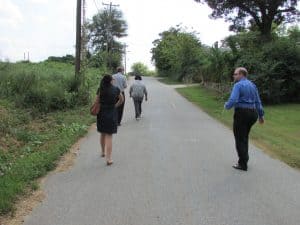
Earlier this year, SCSJ filed on behalf of the Southernside Neighborhoods in Action and two individuals a complaint under Title VI of the Civil Rights Act of 1964 against the South Carolina Department of Transportation. In the complaint, we alleged that residents of the Southernside neighborhood, an economically disadvantaged community of color, were excluded from the decision-making process behind demolition of a pedestrian bridge that connected the community to the adjacent town. The Hampton Avenue Bridge allowed easier access to a grocery store and pharmacy, among many other benefits. While the Hampton Avenue Bridge was allegedly demolished due to age and disrepair, SCSJ found that old bridges that served more affluent communities were not demolished, and that its demolition had a disparate negative impact on the poor residents of color in the neighborhood—a protected group under Title VI.
This summer, the Federal Highway Administration, the federal agency with whom we filed the Title VI complaint, opened an investigation into the case, which was the first big win for SCSJ’s clients.

Yesterday, two federal investigators were onsite examining where the demolished bridge was, and what the alternative was that SC DOT suggested (a 6-lane highway bridge that adds 1.5 miles to the trip, one-way). We first took the investigators on that 1.5 mile walk. We explained to them that now that the pedestrian bridge is gone, people either have to walk very far out of the way on a very busy highway (at least 4 people have been injured in recent years using the 6-lane road for pedestrian crossing) or people illegally and dangerously cross the railroad under where the pedestrian bridge used to be because it’s just too hard/dangerous to walk across the major highway bridge.
After the walking tour, we had small group meetings with the investigators. The first was with state legislators. The second was with local elected officials. The third was with “technical assistance folks”—folks who work with the city/county/local universities who had been supporting the Southernside neighborhood group in trying to keep the bridge. These folks had all provided data that should have convinced SC DOT not to demolish the bridge, but SC DOT never meaningfully engaged with any of the data offered by the community.

Finally, we had a big public forum at a church right across the street from the demolished bridge where community residents were given an opportunity to speak—the chance that SC DOT never gave them during the decision-making process. Approximately 75 community members were in attendance. There had been a big rally and walk Sunday night to drum up attention for the investigators coming on Monday. 103 people attended that Sunday night event, and about half of them walked the 1.5 mile “alternate route.”

At the public forum, folks got to share the effect of the demolished bridge and the further isolation and “choking” of this community.
SCSJ will continue to post updates as the Southernside Environmental Justice case moves forward.
Click here to support SCSJ’s work!
Post by SCSJ staff attorney Allison Riggs on September 10, 2013
